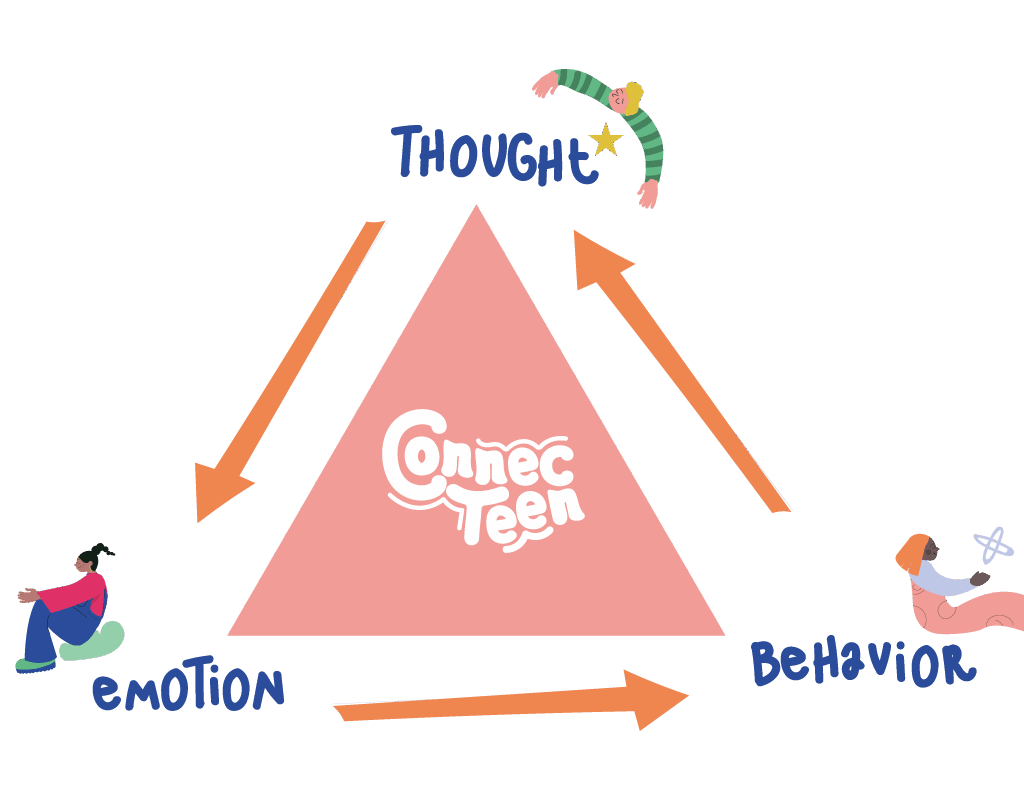Goal: An experience-based understanding of how they can improve their self-confidence by applying knowledge of thought. Creating a feeling of one – we are all having the same challenges in thinking negative thoughts.

Equipment list for session 4:
- PC with Power Point
- Projector/TV to show Power Point
- Flipchart paper
- Flipchart stand
- Black/green/blue markers
- Pencils for the students*
- Notebooks for the students*
- Pencil sharpener*
*iPads or similar can be used if the students can bring their notes to every session
Wellcome – Time: 5 min
Trainers will say to the group:
Last session you learned about thoughts and how thoughts are just thoughts and not facts. You also did a thought experiment that shows the connection between a thought and an emotion. What is something you remember from last session or want to share about your home assignment?
Purpose: To change your thought patterns, you need to start with yourself. You are the master of your thoughts.
Part 1: Exercise the cognitive triad – Time: 15 min
Preparations for the trainers:
DRAW A HUGE RED, AND A HUGE GREEN TRIAD ON THE FLIP CHART

Step by step:
– First ask the class to name negative thoughts. Write them on the top of the triad.
– Next step is to ask an extroverted student to be your example of cognitive triad (demo).
– The trainer will show the Power Point with the different situations presented in session 3
– Thought experiment.
- Trainer: Which area/situations trigger most often negative thoughts in you?
- Participant: Social Media (for example).
- Trainer: When you think about Social Media (if this is what the person said) what do you assume?
- Participant: I assume that everyone judges me when I post something.
- Trainer: An assumption is a negative thought, and assumptions are what holds us back in our lives, and what prevents us from reaching our dreams or full potential. Assumptions are also the biggest cause of misunderstandings in the world.
- Trainer: So, you assume that everyone will judge you. And when you are thinking the thought: Everyone is judging me, how do you feel?
- Participant: Sad
- Trainer: And when you are thinking the thought: Everyone is judging me, you feel sad, what do you do/how do you behave?
- Participant: I post negative comments.
- Trainer: When you are thinking the thought: Everyone is judging me, you feel sad, and you post negative comments, what is a new negative thought that comes?
- Participant: That I am worthless.
- Trainer: When you are thinking the thoughts: Everyone is judging me and I am worthless, how do you feel?
- Participant: Even more sad.
- Trainer: When you are thinking the thoughts: Everyone is judging me and I am worthless, you feel even sadder, what do you do/how do you behave?
- Participant: I withdraw and lock myself in my room.
- Trainer: Thank you for demonstrating this!
The trainer now draws a BIG negative spiral across the cognitive triad, and says: One negative thought leads to another, and then another…until we are here, in the deepest of the deepest of a negative spiral. What is here? (point to the innermost point of the spiral).

- The group will most likely say: Depression, anxiety, tears. Everything they say you can write inside the spiral.
- The trainer will now repeat some of the knowledge about thoughts that was said earlier. For example: Remember that a thought is a thought and not a fact. You have over 60,000 a day. This means that you can choose!
- Trainer to the same participant as before:
- Now that you know this, what is a smart or optimistic thought you can choose instead, when thinking about Social Media?
- Participant: Everyone only cares about themselves.
- Trainer: When you are thinking the thought: Everyone only cares about themselves, what do you feel?
- Participant: It makes me feel calm.
- Trainer: When you are thinking the thought: Everyone only cares about themselves, and you feel calm, what do you do?
- Participant: I put away my phone, or I post a natural picture.
- Trainer: Ok, great. Thank you!
Part 2: Individual work / The cognitive triad – Time: 15 min
Tell the participants to draw the cognitive triad. Choose a situation that creates a lot of stress or other negative emotions. They are free to choose from the situations you presented at the beginning (PP). Then they will take themselves through the Cognitive Triad. First, with negative thoughts. Then with a positive/optimistic thought.
Opening question:
- When you think about situation X
- What do you assume in that situation? Write on the RED triad: Your negative thought on the top of the triad. Write which feeling that thought evoke. Write which behaviour that feeling evoke.
- Then do the same operation on the GREEN triad: When you think about situation X.
- What is a positive or optimistic thought you can choose? Find a positive / optimistic thought to replace the negative. Write the positive thought. Write the feeling the positive thought evoke. Write the behaviour the positive feeling evokes.
Closure/Summary – Time: 2 min
Creating a feeling of one – we are all having the same challenges in thinking negative thoughts. To change your thought patterns, you need to start with yourself. You are the master of your thoughts.

Home assignment – Time: 8 min*
Trainers: Ask the students why doing the home assignment is important! Assignment: Use the cognitive triad! When you notice that you are in the red triad, think/say: Stop! You are not welcome here! Replace it with one positive thought from your green triad.
Acknowledge the class/students – Time 2 min
Find something from today’s session you can acknowledge before you say goodbye.
